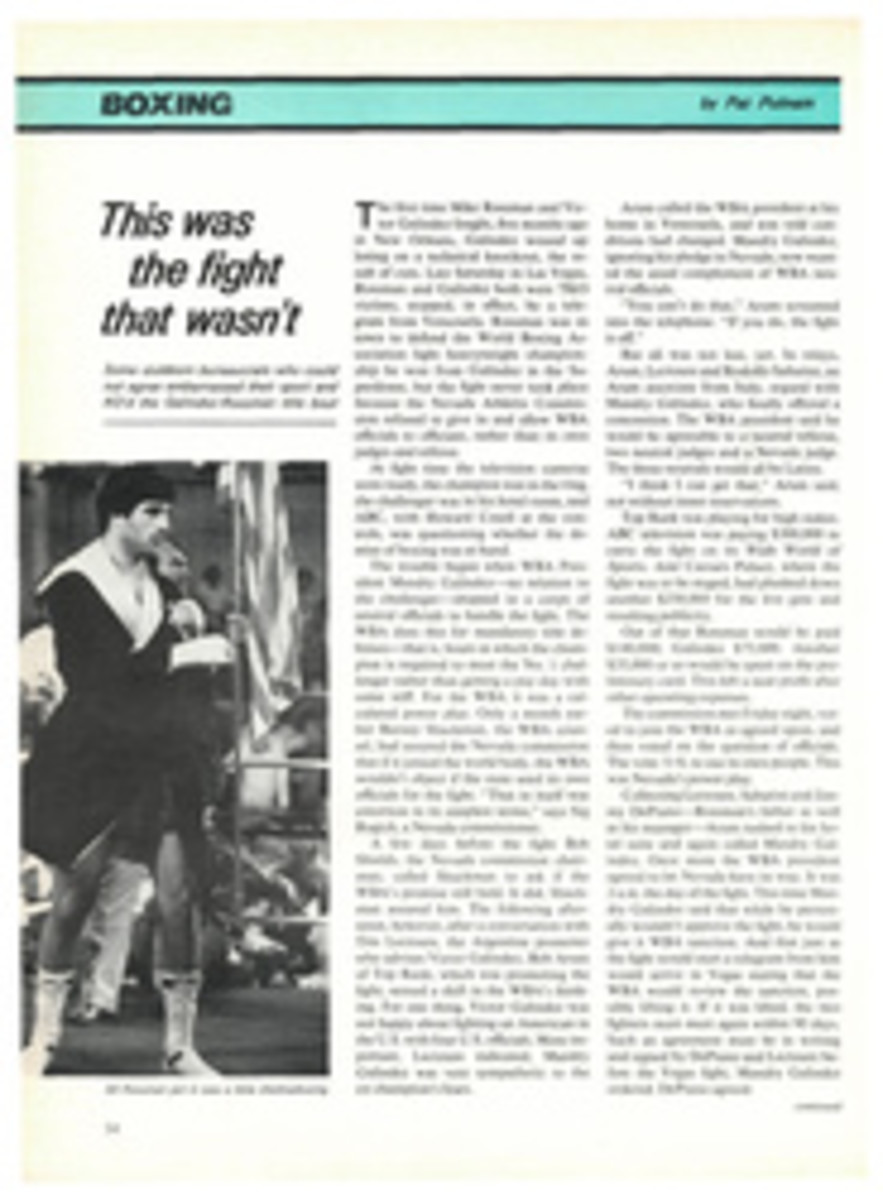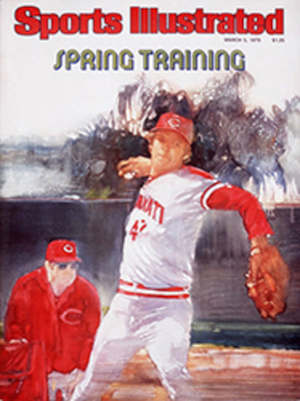
THE TIGERS ARE ROARIN'
After seven years of nonstop salesmanship, LSU Coach Dale Brown has quit talking and started cooking. And for hungry basketball fans in Baton Rouge the taste of success is better than a Creole banquet at Ralph & Kacoo's.
Louisiana State beat Alabama 86-66 last Thursday to run its record to 22-3, clinch the SEC regular-season championship and become the top seed in the league's inaugural tournament next week in Birmingham.
It has been 25 years since LSU last slogged its way out of the basketball bayous. In 1953 and '54 Bob Pettit, now a New Orleans bank executive, led the Tigers to one outright SEC title, one co-championship and two NCAA appearances. In the seasons since, the highlights have been few and the disappointments many—one trip to the NIT in 1970 (with Pete Maravich's sagging socks) and only four winning records in conference play.
Now the Tigers have their best team ever and, according to the polls, one of the five best in the country. This in itself is a notable achievement, but the fact that it was accomplished almost entirely without LSU's best player in the lineup is amazing.
While the Tigers were playing Mississippi a couple of weeks ago, Rudy Macklin was sitting on the bench in street clothes, snapping pictures with a Polaroid camera. Macklin, a 6'7" junior forward, averaged 19 points and 10.6 rebounds last year, but after the first two games this season, in which he had 46 points and 24 rebounds, he broke his left foot in practice and has not played since.
"When Rudy first got hurt I developed a Joan of Arc complex," says Brown. "I felt like a martyr. I had expected an outstanding season, but without Rudy I was worried." Instead of collapsing, the Tigers rose to meet the challenge. "We knew we'd all have to play harder, and after a few weeks we just forgot about him," says sophomore Forward De-Wayne Scales, who has emerged as the new star at Louisiana State. Sophomore Guard Ethan Martin adds, "We didn't know what we were capable of doing, but we wanted to prove to ourselves and everybody else that we could win without Rudy. Now we've learned we can play ball as well as he can."
As it turned out, the person who had the hardest adjustment to make was Macklin. "It's been tough," he says. "You never realize how much you love the game until you are unable to play. All I can think about is that I'm alone and not doing anything. That's why I'm studying three hours a day and, after that, playing cards or chess with the guys. I've got to keep my mind off not playing."
LSU has become so good without Macklin that it boggles the mind to think how good it would be with him. The Tigers lead the SEC in scoring, winning margin, field-goal percentage and field-goal-percentage defense, and have lately shown they can play effectively at either a fast or slow tempo. "We've become a complete team," says Brown. "We're capable of winning it all this year. But we're also out there having fun, too. The players haven't shown an ounce of pressure."
The Tigers have succeeded by accepting and executing roles as sharply defined as the tasks on an assembly line. Oddly, the main roles are the reverse of what one might expect, with the 6'9" Scales handling most of the outside scoring and 6'2" Guard Al Green taking care of the inside punch. Center Lionel Green rebounds, Forward Greg Cook knocks bodies around, guards Ethan Martin and Willie Sims take turns steering the offense, and Jordy Hultberg comes off the bench to fling line-drive jumpers at the basket. Two weeks ago, as the Tigers swept Auburn and Mississippi, Hultberg shot 17 for 21.
Had Macklin been available, LSU's unique Mr. Inside-Mr. Outside combination of Scales and Al Green might never have developed. Scales likes to set up low and then dart out to the top of the lane where he can receive a pass and fire his arching jumper. He is scoring 19.6 points a game on devastating 57.6% long-range shooting. Green goes down low and stays there, sneaking around with slithery moves that produce a bucket or a foul or often both. He is averaging 18.5 points a game on 63% shooting and has made 48 more free throws—a total of 131—than Scales has attempted.
Even though Scales' and Green's playing styles differ widely, both are crowd-pleasing, semireformed showboats. "When I was in high school, people tagged me as being wild and undisciplined," Scales says. "I admit it was true, because I'd shoot bombers from 40 feet, and when I rebounded, I'd kick my legs and swing my elbows. Coach Brown has made me tone it down."
Not all the way. Scales still dunks ferociously, pats referees on the fanny, smiles to one and all, and even tries to control fan reaction. On the road against Kentucky, which LSU has beaten three straight times, Scales motioned for an entire arena of hostile fans to take their seats. "Twenty-three thousand," he said afterward. "I guess that's a lot of people to tell to sit down, huh?" At home, of course, he tells the spectators to stand up and cheer. "DeWayne is like a bumblebee in a glass jar," says Brown. "If I restricted him too much, it would take away his effectiveness as a player."
Green's effectiveness has been developed during a nomadic career that has taken him from New York playgrounds to five different high school and college teams. This count doesn't include the Bronx high school he attended as a sophomore, because he didn't play hoops there. The stops on Green's See America itinerary have been Harlem (N.Y.) Prep, Maine Central Institute, Arizona Western Junior College, North Carolina State and LSU. Not only is he one of the most traveled college players around, but at 24 he is one of the oldest, too.
Green probably would have gone to LSU right out of high school had he been academically qualified for a major four-year college. And he might have gone there after one All-America season at Arizona Western had the SEC allowed freshman JC transfers. The ACC did, but at North Carolina State Green learned that his style and Coach Norman Sloan's philosophy had little in common. So Green packed his bags a final time and headed for LSU. This union had not been possible when Brown had first recruited Green in high school, but now Brown finally has Green, and Green finally has a home for himself, if only for one season.
"I got psyched out at North Carolina State," Green says. "Coach Sloan just wanted me to pass and play defense and not shoot very much. When he finally put me on the bench my second year, I knew I had to get away. If I had tried to stick it out there, I probably would have quit playing and wound up on the streets back home. I've always wanted to make it in basketball, so I decided to put it all into one year. I knew I'd have to do well, and the team would have to be good, too. This year has worked out just the way I hoped it would."
The only folks who have had to wait longer for success than Green are LSU fans. When Brown came to the Tigers after being an assistant at Utah State and Washington State, he began a campaign to drum up basketball interest. As in almost every similar effort, he made some big promises—a ball in every basket, and the good times, they're a comin'. Progress was evident in Brown's first year, when the Tigers finished 14-10 and he was named SEC Coach of the Year. But it was not until last season that LSU was able to improve on that start by going 18-9 and having its first winning record in the league since 1971.
No wonder that, after so much frustration, things got a bit out of hand during the clinching victory over Alabama in Baton Rouge. A couple of items that could not be controlled, at least by the Tide, were Al Green, who made 11 of 15 shots, and Rick Mattick, a seven-foot, 250-pound sub. In 20 minutes Mattick got 10 rebounds, a big reason for LSU's 52-29 advantage on the boards.
Then, with 38 seconds to play and the Tigers ahead 84-66, a huge banner was unfurled from a catwalk high above the floor. It read: SEC BASKETBALL CHAMPIONS 1979, and it seemed a signal for the release of every ounce of frustration in Baton Rouge. As the joint went wild, enraged 'Bama Coach C. M. Newton protested the disruption to the refs, who ordered the game resumed even while cheerleaders danced madly about the court. Not surprisingly, the regular-season final two days later against Mississippi State was such an anticlimax that LSU sustained its fourth loss, 65-57.
"The whole time I've been here, I've known we would eventually have the kind of success we are finally enjoying," Brown says. "But by saying we would be great, I made everyone hungry for it, and I created all my own pressure. When it didn't come in a hurry, I became very depressed that I wasn't getting the job done. I even made a list of all the good things we had accomplished, just so I would know I hadn't been a failure."
Brown can add to his list an SEC title, but he should let Scales and Green hold the trophy and Macklin take the picture.
TWO PHOTOS
After LSU's best player, Rudy Macklin, was hurt, DeWayne Scales (left) came on to average 19.6 points and Lionel Green took over chores under the basket.
PHOTO
Following a long struggle to get things going, Coach Brown is surrounded by cats who can play.
PHOTO
Al Green, the 6'2" half of the unusual Mr. Inside-Mr. Outside duo, likes to duck in close to score.

